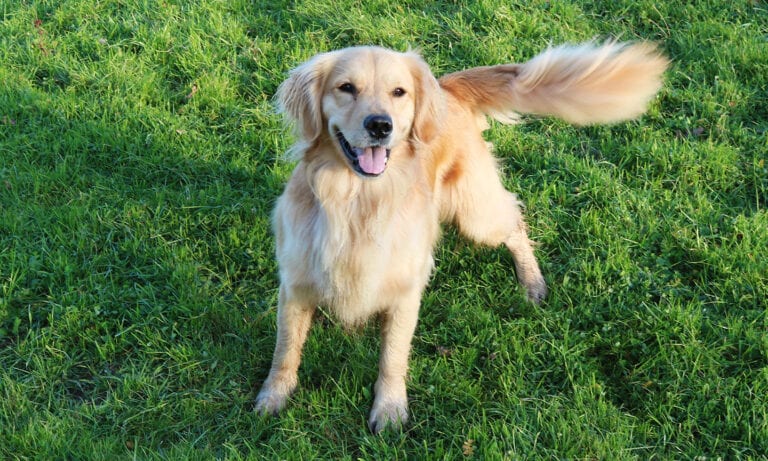If you notice your pup plays rough with others despite obvious cues to stop, or they keep stealing another dog’s toy or incessantly barking in their face, you may be thinking, “My dog is a bully.” And you could be right. It’s likely that you’re witnessing dog bullying. More specifically, you’re witnessing displacement behavior stemming from conflict.
While this behavior usually isn’t malicious, no one wants their beloved four-legged best friend to be the bully (or get bullied) at the dog park.
We talked to two experts about how to identify a dog bullying other dogs, where this displacement behavior comes from, and how to teach dogs new, more socially acceptable behaviors.
In This Guide:
Signs Your Dog May Be a Bully
Dogs aren’t bullies in the traditional sense, meaning they don’t typically seek out another dog to pick on, according to Leslie Sinn, DVM, DACVB, CPDT-KA, founder of Behavior Solutions in Ashburn, Virginia. But conflict and displacement behaviors, as well as uncontrolled and/or aggressive behaviors, can come off as bullying.
Here are the most common signs of bullying behavior:
- Ignoring social cues or cut-off signals from other dogs
- Being overbearing in social settings, like nudging for attention
- Chasing or charging at other dogs
- Over-the-top responses, like running into other dogs and knocking them over
- Nipping at other dogs, despite social cues to back off
- Growling or snarling, and lip raising with their ears back and tight
- Stealing toys or food
Keep in mind that a dog who’s labeled as a bully is not necessarily an aggressive dog.
In most cases, dogs who are perceived as bullies just don’t know how to read social cues, or they don’t know how to express their emotions. Or they might get along fine with one dog but not others (this is called “dog selective”).
What Causes Dogs To Bully?
Many things can contribute to dogs exhibiting bullying behavior, including maternal stress, genetics, environments, socialization, and learned behaviors. Here are the most common causes:
Poor or Inadequate Socialization
A dog’s socialization window is between 2–18 weeks of age. During the socialization period, dogs learn how to interact with other dogs and how to read body language.
A lack of socialization in their younger years is often the root cause of bullying behavior, says Brett Reynolds, CPDT-KA, a dog trainer and director of dog care at The Dog Stop®, in Pittsburgh, Pennsylvania.
When dogs fail to recognize signs of distress or discomfort from a social partner, bullying can be the result, he says. This is common in some rescue situations when dogs just don’t know what the right behavior is.
Incompatibility of Playmates
If both parties aren’t on the same page about what’s fun, the more overbearing, high-energy dog can be seen as bullying.
Genetic Predisposition
Certain breed groups that prefer rough-and-tumble or hard, physical interactions are often labeled as bullies.
Dr. Sinn, who is also a dog trainer, says herding dogs, like Border Collies, may often come across as bullying because their natural herding instincts can be off-putting to other dogs.
Opportunity
Sometimes dogs are opportunistic and take advantage of others that they perceive as easy targets, says Reynolds.
Boredom/Lack of Exercise
If a dog isn’t getting enough exercise or mental stimulation, they might have pent-up energy that comes out as rough play.
Frustration
Just like with humans, frustration can manifest as bad behavior, especially if the other dog isn’t responding to the bully dog’s attempt at play.
Overstimulation
Some dogs get overstimulated or over-aroused like a hyperactive toddler, Dr. Sinn says. When this happens, they have no impulse control.
What To Do if Your Dog Bullies Other Dogs
If you notice your pup bullying dogs, the next question becomes: “What should I do if my dog is harassing their playmate?” Fortunately, you can try to modify your dog’s behavior and encourage appropriate play. Modification introduces a behavior that’s more socially acceptable.
Remove Them From the Situation
The best—and most important—thing you can do is remove them from the situation. It’s incumbent on the owner of the dog who is showing inappropriate behavior to act as a social coach to intervene and interrupt, Dr. Sinn says.
Some people think these situations are just a dog being a dog and that they’ll work it out on their own. While that’s true to an extent, Dr. Sinn says it’s up to you to intervene if your dog is being wildly inappropriate.
This doesn’t mean getting into the middle of a dog fight if the situation has escalated, but if your dog is exhibiting bullying behavior, get them away from the other dog before the situation gets worse.
Look for Patterns
If your dog is frequently showing signs of bullying, Dr. Sinn recommends assessing what situations cause your dog to get overstimulated or out of control. Something is likely going on that’s too much for the dog, she says.
If you can identify patterns, make changes in how you approach playtime. For example, instead of going to a dog park with 100 dogs, you may want to set up a one-on-one playdate with another dog whom your pup knows. It’s helpful if the two dogs have a similar play style.
If your dog only shows signs of bullying around dogs who are bigger or smaller than them, try to limit social interactions to other dogs of the same size.
Lead With Positive Reinforcement
While your first instinct may be to yell or yank your dog away, this can contribute to your dog being overwhelmed and anxious, and make the situation worse. Instead, remain calm and do what you can to de-escalate the situation.
Dr. Sinn says the best approach is to:
- Recall your dog.
- Praise them for listening to the command.
- Ask them to sit with you until they can take things down a notch.
- Secure them with a leash for a while (if they're off-leash), so you have more control over the situation.
This is called downshifting, and the idea is that when you remove the dog from the excitement for a bit, they’ll calm down and be able to return being less overwhelmed.
Get Professional Training
If you can’t get a handle on the situation on your own, Dr. Sinn says you may want to get help from a professional trainer.
A professional trainer can help you interpret your dog’s behavior and whether it’s normal or abnormal, then work with you to properly train both you and your dog. (It’s important that you know what normal behavior looks like and what’s socially acceptable—and how you can help your dog!)
They’ll also be able to teach the dog appropriate cues, so you intervene more effectively when needed.
How To Prevent Bullying in Dogs
The best way to make sure your dog isn’t bullying other dogs is to prevent it in the first place. Below are some things you can try.
Proper Socialization
Proper socialization is one of the most important things that prevents bullying, Dr. Sinn says. Ideally, you’ll expose them to different people, dogs, and environments when they’re young. This can help them develop proper social cues.
However, if you have an older dog, it’s not too late. You can still work on socialization, but you might benefit from a professional trainer’s help.
Give Them Basic Training
If they’re not already trained, making sure your dog understands and listens to basic commands can go a long way to prevent bullying, says Dr. Sinn.
It’s important that they come when called, as this ensures you can intervene and give the dog a minute to take a breather.
Positive Reinforcement
Positive reinforcement is important even if your dog is exhibiting unwanted behavior. Dr. Sinn says the goal is to reward good behavior—not punish any behavior.
When your dog responds to your commands or plays well with others, give them a highly motivating treat.
Over time, this positive response can help discourage bullying. Again, it may be helpful to work with a professional trainer, especially with older dogs.
Supervised Play
Just like children, it’s best to supervise playtime between dogs, especially when they’re in larger groups.
Watch for signs of bullying, and remove your dog from the situation as soon as possible if you see any.
Play With Your Dog Regularly
Because bullying can stem from boredom or frustration, playing with your dog regularly can help release pent-up energy, says Reynolds.
Take them on walks and give them interactive toys that stimulate them between more physical activities.
Signs Your Dog May Be Getting Bullied
On the flip side, your dog may be bullied by another dog. Typically, your dog’s body language will give you big clues about how they feel.
Here are common signs your dog may be getting bullied:
- Trying to get away from offending dog
- Fear behaviors, like lip licking, pinned ears, a tucked tail, and paw lifts
- Yawning and/or lip licking
- Yelping
- Avoidance behavior, like trying to hide or run away
- Trying to get behind owners
According to Dr. Sinn, all of these are signs your dog is overwhelmed and needs your help.
What To Do if Your Dog Is Getting Bullied
So, how can you help a dog who may be getting bullied? Our experts recommend the following.
Remove Them From the Situation
Just like the reverse (when your dog is the bully), you’ll want to remove your dog from any bullying situation. Ideally, the other dog’s parent would get the offending dog to back off, but if that’s not happening, you must control what you can—and that’s your own dog.
Don’t confront the other owner or try to pull the canine bully away from your dog. Instead, take your dog and leave the situation as calmly as possible.
Don’t Escalate Things
With human bullies, the advice is often to stand up for yourself, but it’s different in the canine world. You don’t want to encourage your dog to engage or try to get your dog to be more assertive.
Dr. Sinn says this can trigger a fight, which could quickly turn into an emergency. Instead, stay calm and remove your dog from the situation.
Reconsider Play Sessions
If your dog getting bullied is an isolated event, removing them from the situation should do the trick. But if this is a regular occurrence, you may want to rethink playtime.
Dr. Sinn recommends taking note of overwhelming situations and finding more socially appropriate places for your dog to have fun. If it’s one particular dog bullying your dog, you might have to end that friendship and find other doggy companions with play behavior that more closely aligns with your dog’s.
If your dog seems to always get bullied, skip the dog parks and consider lower-key options, like playdates with one or two good friends; a more stable small group of dogs; or an in-home daycare instead.
Share:













